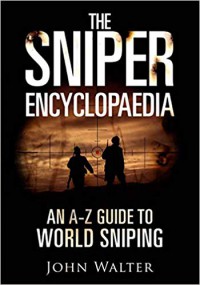A must for researchers and a fascinating book for anybody interested in the topic.

I thank Rosie Croft from Pen & Sword for providing me a hardback review copy of this book that I freely chose to review.
Let me be clear about this: I know next to nothing about weapons in general, and I only know about snipers and their weapons of choice what I’ve picked up in TV series and documentaries, movies, and books. So this is not an expert’s review, rather the opposite.
You’ll probably ask why I was interested in this boo. Partly, because I’ve watched movies and news items about snipers (both modern and historical), and it’s impossible not to recall certain events and think about the people and the weapons behind them. Also, because I’m a writer, and I know how important it is to have reliable sources to research topics we want to write about. I’m also a translator, and after dedicating a fair amount of my time to working on books by other writers, I’ve discovered how complicated it can be to find the right word or term to refer to an object or device you know little about, and how complex it can get to describe an action that might come natural to an expert on the field, but is anything but for somebody totally new to it. Of course, you also have to think that not all readers are going to be experts either. How do you explain something that you don’t understand yourself? After trying to make sure a fight scene in a petrol tanker sounded accurate without having any idea what it looks like inside, I can tell you it’s not easy.
So, beyond my personal curiosity, (and yes, I must confess I’ve always wondered about the kind of training and personality required for somebody to be able to focus on such a task and not think… well, you know what I mean), I thought this sounded like a great resource for researchers and writers, and the reviews from people who knew about the subject reassured me that it wouldn’t disappoint.
And it didn’t. The book is fascinating and, as you can imagine, packed with information. The author explains his methodology, and clearly states that although he has tried to include as much information as possible, the sheer numbers of people and weapons made it necessary to scale down the size of the project. The availability of data was another difficulty. The book refers mostly to USA, UK, German and Russian snipers, and mostly those in the military (Simo Häyhä, a Finnish sniper credited with somewhere between 505 and 542 kills, depending on the sources, and who proved to be a nightmare for the Russians, who called him ‘the White Ghost’, is also included, and his memoir, called The White Sniper, sounds fascinating, I must say) and/or security forces, and Walter explains that in some cases (for example when having to choose weapons and manufacturers), his personal taste has played a part. He has also included more detailed entries about snipers whose biographies have been published, as people can easily access more information. (There have been, and are, many snippers in the armies of other countries, but their details are not available to outside researchers).
The author includes a page on bibliography and sources, dividing it into general studies, genealogical details, weapons and equipment, and tactics and training. Those include online resources and books that will delight people keen on digging deeper into the topic.
The encyclopaedia is, of course, organized in alphabetic order and full of illustrations, mostly photographs, but also drawings with details of sights and weapons. There are also lists of snipers, some about specific conflicts (WWI, for example), or even battles (Leningrad snipers is one of those), but also lists of male and female top snipers (they are both Russians, as it seems the Russian army uses snipers far more than any others). As an outsider it is a bit strange to think of what these numbers actually mean (the top male “scorer” has over 700 “scores”) and reading this book one’s mind boggles at times. I was fascinated, at the same time, by the female snippers, their pictures, and their stories. Among them, one that will stay with me is the story of Nataliya, or Natasha, Kovshova who fought during WWII and died with Mariya Polivanova after being badly injured, by pulling the pin of a grenade and taking some of the enemies with them. They were made Heroes of the Soviet Union posthumously and, although it seems there have been some questions as to what exactly happened, the basic facts are correct.
As I said, there is especial attention given to snipers who have written books about their experiences or have had books written about them, and that makes this encyclopaedia interesting to those trying to explore or find personal accounts on the topic, as it provides biographical information and also information about the content of the book, if available in English. As the back cover summarises, this book includes: 750 standard entries, 100 extended features and ‘top 20’ lists, over 400 biographies and 200 illustrations, and I recommend it to anybody who wants to gain a solid basis in the knowledge about sniping, the people involved and their weapons. Another great book by Pen & Sword.
 8
8







